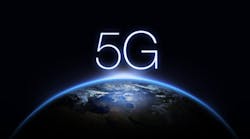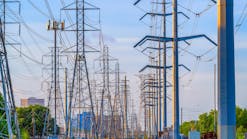What do high-definition movie download speeds and utility pole attachment requests have in common? They’re both set to increase with the introduction and adoption of fifth-generation (5G) cellular communications technology.
The 5G network rollout is underway. It is estimated that this latest cell technology will result in 100 million U.S. mobile connections by 2023 and 1.9 billion global subscriptions by the end of 2024. While a boon for consumers, 5G can create challenges for utilities not ready to handle the necessary infrastructure support or not prepared to capitalize on 5G technology capabilities.
What is 5G Technology?
Mobile network technologies started in the 1980s with the first generation (1G) of analog voice technology, typically in the form of large car phones. In the 1990s, second-generation (2G) cellphone communications went digital, making for smaller mobile phone sizes and the ability to text message. The 2000s introduced third-generation (3G) mobile phones capable of taking photos, playing music, and surfing the internet.
Smartphones brought forward fourth-generation (4G) cell technology with faster speed, stylish design, and the introduction of mobile applications. Standards for 4G smartphones were established as long term evolution (LTE) that aims to indicate improved connectivity.
While 5G will use the existing low-band and medium-band radio wave spectrum that 4G relies on, it will also tap into a high-band range, known as millimeter wave or mmWave. The mmWave offers larger bandwidth and is the driver for significantly increased speeds.
According to many industry analysts, 5G has potential to revolutionize the market with mobile broadband and communication networks up to 100 times faster than speeds available today, supporting 100 times more devices and five times lower latency.
However, while the mmWave supercharges cell technology speed for many more users, it has a lower coverage area and cannot penetrate buildings or structures. This is where the impact of 5G for utilities begins.
Envisioning 5G Efficiencies
Utilities are in a unique position to benefit from the 5G revolution. When preparing resources and systems to cope with 5G infrastructure needs, utilities should also dedicate time to strategize how this technology may streamline operations in the future.
Connected services types have been defined for how 5G will be deployed. This requires a concise understanding of the use cases that will help utilities determine how 5G might increase efficiency, alter operating models and even open up new revenue streams. Possibilities include:
Enhanced mobile broadband (eMBB): This has potential to usher in incomparable download and upload speeds plus fast online access even in densely populated areas. As one of the first 5G benefits to be realized, now is the time to consider how eMBB might benefit utilities.
Massive internet of things (mIoT): With capability of low-power and low-complexity embedded sensors using mIoT, utilities can monitor and control devices and equipment to monitor asset functionality and deal with emergency issues remotely and quickly.
Massive machine type communications (mMTC): This is an expected connected service from 5G that will allow devices, sensors, machines, and equipment to communicate with each other autonomously. Less dependent on low latency, mMTC offers long battery life and can provide utilities with unique benefits for remote or critical asset monitoring.
Ultra-reliable and low latency communications (uRLLC): This is expected to optimize mission-critical communications and remote monitoring of critical infrastructure. Replacing hand-held, push-to-talk devices, uRLLC will offer low round-trip latency between devices and real-time reactivity to help monitor and protect the security of utility assets.
Supporting 5G Installations
5G offers tremendous potential for consumers, businesses, and industries around the world. For utilities, there is great promise for innovation and efficiency from 5G technology, but first, there is an impact on infrastructure.
Tapping into the mmWave is needed for 5G to deliver the dramatic increases in cell technology speed expected. To do this, telecommunications companies will require the installation of new small cells and antennas. However, because the mmWave spectrum has a shorter range, these small cells will be needed in higher numbers and must be installed closer together.
To support 5G, it is estimated that 800,000 new small cells will be required to be installed by 2025. These needed small cells will result in a dramatic increase in pole attachment and other infrastructure attachment applications for utilities to review and process.
Likewise, the Federal Communications Commission (FCC) has committed to expedite 5G. In the FCC’s Facilitate America’s Superiority in 5G Technology (5G FAST Plan), utilities are required to execute the needed infrastructure installations within set time frames and fee structures.
Utilities need to consider now how to plan to process and manage the permits, paperwork, applications, and requests to support what is required to help 5G become a reality.
Utilities should dedicate time now to set up the needed processes and resources to efficiently handle expected 5G infrastructure requests. At the same time, it is not too early for utilities to explore the opportunities 5G will bring to improve operations and expand customers’ services.


